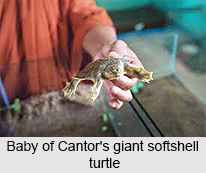 Cantor`s Giant Softshell Turtle or Asian Giant Softshell Turtle is an Indian Reptile that bears a scientific name "Pelochelys cantorii" is a species of freshwater turtle. The turtle is named after Theodore Edward Cantor.
Cantor`s Giant Softshell Turtle or Asian Giant Softshell Turtle is an Indian Reptile that bears a scientific name "Pelochelys cantorii" is a species of freshwater turtle. The turtle is named after Theodore Edward Cantor.
Size of Cantor`s Giant Softshell Turtle
Cantor`s Giant Softshell Turtle has a broad head and small eyes close to the tip of its snout. The carapace is smooth and olive-colored. Juveniles may have dark-spotted carapaces and heads, with yellow around the carapace
Structure of Cantor`s Giant Softshell Turtle
Cantor`s Giant Softshell Turtles can grow up to 6 ft in length and is the world`s largest extant freshwater turtle, this maximum size and title is murky at best. Apparently the largest specimen carapace length is 129 cm, is considered suspect and the heaviest specimen known (weighing approximately 250 kg (550 lb) was actually a misidentified Yangtze Giant Softshell Turtle. A more realistic range of carapace length for this species is reportedly 70 to 100 cm (28 to 39 in) and it is one of about a half-dozen Giant Softshell Turtles that reach exceptionally large sizes that is in excess of 100 kg (220 lb) in mass.
Feeding of Cantor`s Giant Softshell Turtle
Cantor`s Giant Softshell Turtle is an ambush predator and primarily carnivorous, feeding on crustaceans, mollusks and fish (although some aquatic plants may also be eaten).
 Lifespan of Cantor`s Giant Softshell Turtle
Lifespan of Cantor`s Giant Softshell Turtle
Cantor`s Giant Softshell Turtle spends 95% of its life buried and motionless, with only its eyes and mouth protruding from the sand. It surfaces only twice a day to take a breath, and lays 20–28 eggs (about 1.2 to 1.4 in diameter) in February or March on riverbanks.
Behaviour of Cantor`s Giant Softshell Turtle
Cantor`s Giant Softshell Turtle is found primarily in inland, slow-moving, freshwater rivers and streams. Some evidence indicates its range extends to coastal areas, as well.
Concentration of Cantor`s Giant Softshell Turtle
Cantor`s Giant Softshell Turtle is found in eastern and southern Indian states like Assam, Gwahati, Silchar, Malda District of West Bengal, Bangladesh, Burma, Thailand, Malaysia, Laos, Cambodia, Vietnam, eastern and southern China, Singapore (extirpated), the Philippines (Luzon and Mindanao), and Indonesia (Kalimantan, Java, and Sumatra).
Threat of Cantor`s Giant Softshell Turtle
Cantor`s Giant Softshell Turtle is regarded as endangered, and has disappeared from much of its range. Prior to 2007, it was last seen in Cambodia in 2003.











